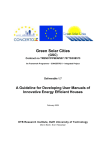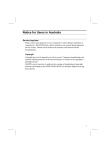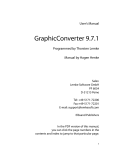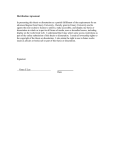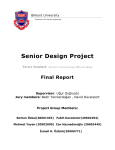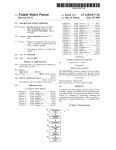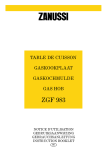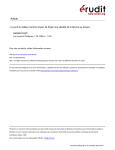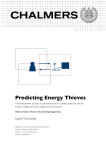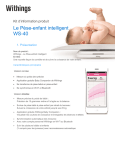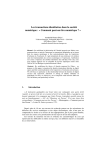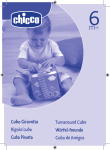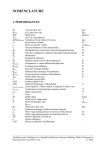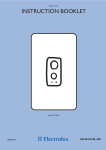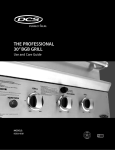Download 247815. - TU Delft Institutional Repository
Transcript
Green Solar Cities (GSC) Contract no TREN07/FP6EN/S07.70775/038573 6th Framework Programme – CONCERTO II – Integrated Project Deliverable 1.7 A Guideline for Developing User Manuals of Innovative Energy Efficient Houses February 2009 OTB Research Institute, Delft University of Technology Merve Bedir, Evert Hasselaar 1 Deliverable D1.7 A Guideline for Developing User Manuals of Innovative Energy Efficient Houses Work Package 1 February 28, 2009 Co-ordinator: KUBEN Work package 1 leader: OTB Research Institute for Housing, Urban and Mobility Studies of Delft University of Technology Contractors: Kuben Urban Renewal Denmark (Kuben) Cenergia Energy Consultants (Cenergia) City of Salzburg (Salzburg City) Gswb – Gemeinnützige Salzburger Wohnungsgesellschaft mbH (Gswb) Heimat Österreich (HÖ) Salzburger Institut für Raumordnung & Wohnen (SIR) Salzburg AG Steinbeis GmbH & Co KG Technologietransfer (Steinbeis) Die Salzburg gemeinnützige Wohn- und Siedlungsgenossenschaft (DS) European Green Cities ApS (EGC) DONG Energy Green Valby Valby City Council Lund University Delft University of Technology (TU Delft) WE Consultants Sustainable Building (WE) EMI Non profit company for Quality Control and Innovation in Building (EMI) This is a publication from the Green Solar Cities consortium www.greensolarcities.com GSC is supported by the EU commission under the Sixth Framework Programme. OTB Research Institute for Housing, Urban and Mobility Studies (www.otb.tudelft.nl) Delft University of Technology P.O. Box 5030, 2600 GA Delft (the Netherlands) Phone: + 31 15 278 7578 (M. Bedir) and + 31 15 278 7871 (E. Hasselaar) Telefax: + 31 15 278 3450 [email protected] [email protected] 2 GREEN SOLAR CITIES A Guideline for Developing User Manuals of Innovative Energy Efficient Houses Workpackage 1 - Deliverable 1.7 Merve Bedir Evert Hasselaar OUTLINE Part A. User manual Part B. Background 1. Introduction 1.1. Aim, target audience, focus 1.2. What is a user manual, what does user friendliness mean? 1.3. Actors in volved in the production of user manuals 2. The Occupant 2.1. Effect of occupant behaviour on energy performance 2.2. Comfort, perception, adaptation, satisfaction 2.3. Parameters of user behaviour 3. Developing a User Manual 3.1. General contents of a user manual 3.2. Reference material 4. User aspects of the technologies in GSC communities 5. Conclusions and recommendations Appendix 3 Part A. User manual Dear occupant, You live in an energy efficient house. This may bring new experiences and also questions: do I use the house in a way that gives optimal comfort, is the energy performance as it was intended and how do I behave when extreme indoor climate conditions occur, for instance overheating or poor indoor air quality? This manual wants to support you in making the dwelling a home for our household, and the block a secure social community. You have a crucial role in reaching those qualities. This manual is not written for your personal circumstances, because we do not know the specifics of your house and block. We present in this manual general information that can help you in reaching the best enjoyment of your house. The neighbourhood The expression goes: your neighbour is your best friend. Social contacts in the neighbourhood can support you, guide you in finding your way. You can exchange experiences and you get help with how you reach optimal living comfort. Through your neighbours you will find the experts that can help you out with technical problems, with resetting an appliance that stopped, with answer to the question whether you need to consult the home owner or an expert. Social contact in the neighbourhood is crucial to quality of life, so the first recommendation is to invest in social contacts: take action today. The home owner You can be sure that one day a problem occurs, a breakdown, such as a door that does not close properly, or is too cold. Keep the telephone number of the person that you are supposed to contact at hand. Tell in detail how you experience a problem. Try not to give the diagnosis of the problem and do not mix your complaint with what you think must be done. Any complaints deserves a reliable diagnosis and to reach that, you must communicate well with experts or the person who does the intake. Problems between occupants and the owner or their representatives occur in most cases when communication fails, when roles are mixed up. From communication comes cooperation, from lack of horizontal communication comes conflict.We wish you a good communication when you have questions or complaints. Energy performance Your block has devices and constructions to help you to save energy, to reduce the emissions of carbon dioxide. All bits and peaces that reduce the burning of fossil fuels help to limit climate chage and make society less dependent on a gas- and oil based economy. The performance quality of your block is ready for the future. Congratulations with this quality! Because of the focus on energy, we suggest that you keep control of how much heat and electricity, fossil- and biofuels you use. Energy comes in and goes out of the house. The 4 warmth of the sun comes in, persons give heat, electrical appliances loose heat. In the winter time this is welcome, while in warmer periods this may contribute to overheating. The extra heat comes from heaters or district heating systems, based on all kinds of sources , for instance residual heat from power plants.Any heat respresents living costs and together with climate reasons it is important to save on using it whenever possible. The temperature, the level of lighting, hot water use, transportation etc. are energy factors. Hardly any house needs mechanical cooling in the summer; you can use cool outdoor air to reduce the temperature and you can prevent overheating by shading the sun and turning off some appliances to reduce the heat load. Energy flows represent a balance and when you understand the “big fishes” it will be easier to use energy efficiently. One strategy to know more about the energy balance is to register weekly how much heat, gas or oil and electricity you use. Find out what each appliance uses by applying meters in wall sockets: they can tell you within a week how much these appliances will use on a yearly basis. Make a list of all the items of your energy balance and gradually work this balance out in more detail: you will be surprised how much appliances such as the freezer, the transformers need. Awareness of the balance helps to reduce energy use by precise control. How far can you go? Heating Well insulated houses are easy to keep at high temperatures. Also, the temperature differences are small, so the risk of draught is minor. This allows you to keep doors open and still maintain an even temperature. But why should you? For your body it is good to adapt regularly to different temperatures. A temperature of 25 oC or more and light clothing does not need to be what you get accustomed to, unless your metabolism is low, when you are old or sick etc. Move your limbs when you get cold, instead of turning up the heat. The advice is to keep your bedroom cooler and your living room normally at 20-21 oC during the daytime. Because well insulated houses tend to have heaters with small capacity, they cannot heat up in short time. Turn the heat down only 3-4 oC when you go out or go to sleep, so the houses is still relatively warm when you want to heat it up a little more. Turn it to a lower level when you leave the house empty for a longer time. The house can have a variety of heating services, both collective and individual, central and local. Fuels can differ as well. The heat can come from warm air, low temperaure wall heating, floor heating, a wood stove, electrical resistance heaters. The selection of appliances can be optimised on the basis of comfort, initial costs, energy cost, emissions, ease of control and maintenance. The controls can be smart or manual. There is no preference for manual or automated controls, from the point of view of energy performance. Mnaual control and selective use is very efficient, but more complex systems may perform better with clock thermostats and temperature-adaptive temperature settings etc. The advice is: be critical and know what you choose for: comfort, cost effciency, energy efficiency. Cooling The better a house is insulated, the more cooling may be needed, but not by definition. Well designed houses may hardly suffer from overheating. But small and well occupied houses will overheat, in the summer time or when the sun is low and enters when the house has the desired indoor temperature already. Many strategies can be followed to prevent overheating: a. Start the day at a low temperature and expect the sun to help in reaching the desired condition. When the sun stays behind the clouds, you can use the heater instead; 5 b. Turn down heat sources that allow slective use, such as lights, stand-by transformers, maybe also the tropical aquarium. Avoid activities that produce much heat, such as the oven, meals that require extensive boiling. High temperatures ask for other menus! c. Shade the sun, using outdoor shades: blinds, louvres, a sheet. Indoor shading is not very effective as the cavity between the glazing and the blind will heat up, turning the window into a radiant heat source (in the summer!). It may be best to keep windows closed as long as possible, because the sun through (three blades of ) glazing may produces less heat that direct sunshine through an open door or window; d. Turn the ventilation to high volume, and (if provided) use the bypass in the heat recovery ventilation system; e. Finally: open windows to allow good outdoor air circulation or cross flow. Outdoor air will be (much) cooler that indoor air and with large volumes of cool air, the house can be cooled in a passive way. Hot water In energy efficient houses the energy needed for domestic hot water may be more than needed for heating, especially with three or more persons taking a shower every day. Showering produces much moisture, which could lead to mould problems in the bathroom or bedrooms. The droplets of water that stay behind on tiles are the major source of dampness. Moisture production is low when showers are taken in shower cubicles, and in short sequence. Also, wiping the tiles with a rubber strip, to drain the droplet off, reduces the moisture level. Solar water boilers have best performance when showers are taken in the evening or morning instead of in the daytime. The number of minutes for a shower (3 vs 6 minutes) is crucial for the energy and water use, and also the volume of water per minute ( 5 vs 12 dm3/min) makes agreat difference in energy use. Many showerheads allow selection of large or small amount (narrow of wide flow) of water. Regulating relative humidity Many occupants of well insulated houses complain of low relative humidity in the winter time. The reason is the warm indoor air and the ventilation level, based on outdoor air with very little humidity. When dry air creates irritation of eyes or the respiratory tract, the concentration of irritant pollutants is probably too high. When you want to combat low relative humidity by ventilating less, or by producing moistere through evaporation, cooking etc, then the pollutant level may be more important for the irritating effect than the effect of low humidity level. The advice is to ventilate more and to keep the temperature low. Try it and sense the difference! Remember how nice the cold crispy air outside is: very dry but not irritating so much. Keep drinking water to help your body replenish the sensitive parts. Many “moisteners”consume energy and have negative side effects, such as noise, sometimes Ozon production and often production and spread of bacteria and viruses. They are costly and better be avoided. Ventilation Enough fresh air is the cornerstone of healthy housing. Then comes energy performance. Each house and even each room in a house has a balance of fresh air coming in and used air being exhausted. The quality of in-out flow and circulation influences the efficiency of the ventilation. Cross flow over two facades of a room is roughly four times more efficient than ventilation through one single window. The higher the efficiency is, the less risk of draught and the lower the electricity use of the fan. 6 The ventilation services should have control of three functions: a. basic permanent (non controllable) ventilation to remove permanent pollution from the construction, furniture etc., for instance radon and formaldehyde; b. user dependent ventilation, with control options, depending on the number of people and pets, their moisture and smell production, and emission from normal activities c. peak ventilation, for instance when many people are present (parties), during cooking and also to correct extreme conditions, for instance overheating and pollutants (smoking). The basic ventilation volume depends on individual building and decoration characteristics. It will need to be approximately 50% of volumes according to the minimum of the Building Code. User dependent ventilation is between 50 and 200% of the minimum requirements of the Building Code. Peak ventilation requires a flushing service per room. Separate fans, in cooker hoods, are sometimes applied in the kitchen. The need of this application depends on the volume of the central exhaust system. Sometimes the volume of air must be increased to produce enough heat (preheated air). The suggestion is to keep the ventilation at high volume, in systems where good ventilation does not cost energy. This is the case with Heat Recovery Ventilation with high efficiency heat exchanger and during the heating season: the high setpoint reduces energy consumption and improves air quality in the winter! When no heat is needed, ventilation by natural means is sometimes an option, but it depends on the design for both mechanical and natural ventilation. To support natural ventilation, every room would require a well controllable natural inlet opening (window or large vent that is easy to handle, that protects against rain and is safeguarding against storm and burglars). The ventilation air volume in bedrooms should be enough for (often) the two persons that use this room: a permanent volume of at least 7 dm3/sec per person during sleep. Flushing for short periods (twice a day for 15 minutes, which seems to be the popular German and Austrian ventilation behaviour) is sure not enough to prevent exposure to high concentrations of metabolic products of humans, such as dampness and smell and CO2 etc., and does not support a healthy indoor environment. When mechanical systems cannot be used at high volume because of the noise, there are reasons to complain with the owner of the house. Technical measures can solve this noise problem: by enclosing the fan unit in a cupboard, by improving the sound silencers, support easy flow through the ducts and from the dampers, and increase the number of dampers to reduce the air speed and thus the noise level. Lighting Daylight is good for our health: the bio-clock that regulates our sleep is set to the proper time by exposure to clear daylight, and exposure to the sun is important for vitamin production and psychological well-being. Unblocked daylight into the house is the basis for good health, also for contact with outside, and for solar gains. Artificial lighting during the daytime can be avoided by daylight openings at good locations. Lighting however is needed: for hobby and reading, for safe circulation and for kitchen work. Selection and use of lighting fixtures is the responsibility of the users. Mind the heat production. Lights can be used to add local “personalised” heat. 7 Maintenance Maintenance jobs require periodic care: cleaning every few days or weeks, adjustment of appliances for the summer or winter use, inspection by professionals, reapir in cases of breakdown. Maintenance influences the comfort level, even the energy performance. Practical experience learns that in the range of 50% of breakdowns occur within a month of a maintenance job, so it is relevant to have technicians who know what they are doing. A contract with feasible performance criteria, including a description of the minimum activities, including what has to be tested during a visit, is recommended for all maintenance jobs that are too complex for the actual residents. Maintenance activities should be described in separate mauals, attached to the appliances involved. Examples: Filters and inlet ducts Filters in inlet flows of fresh air need to be clean, to prevent fouling of fresh air or exposure to irritating aerosols. Filters require cleaning at monthly intervals and replacement in 6 tot 12 months, depending on the pollution level in outside air and the filter type. Inlet ducts will have a layer of deposited material, also depending on the flow speed, the quality of filters and of ambient air. It is advised to inspect the ducts for the need of cleaning. Cleaning requires a brush and vacuum cleaner. As a rule, the ducts should be cleaned in intervals of 8 years or shorter. Dirty means: the shiny metal cannot be seen. Learning by doing User friendly appliances support learning by doing, as goes for telephones and digital video recorders. Still, you may need some help the first time, either by following the steps from a booklet or by somone showing how to do it. The problem with automatic behaviour is how often you practice: every day or only when the seasons change, or only when maintenance jobs are needed. Maybe you wait until a breakdown. Two strategies are advised: a. Ask for a proper user manual for the periodic activities that are needed to have optimal comfort, minor health risk and efficient energy use, without breakdowns. b. Ask for involvement in the design process before houses are built or renovated and in setting up a maintenance policy. And remember: good communication is the start of more cooperation. Where to get information: Fill in the contact persons for: -windows and doors -ventilation -heating and hot water -control systems, including sun shding devices -lighting -cleaning windows -cleaning public areas of the building -outdoor environment: garage, playground, green areas etc. 8 Part B. Background 1. INTRODUCTION 1.1. Aim, target audience, focus One of the goals of the Green Solar Cities project is to overcome barriers related to HVAC installations at the side of end users and to optimise energy savings and costs. In this respect, the user aspects of the RUE and RES technologies were evaluated and reported in deliverable 1.6: ‘User Tests of Best Practice RUE and RES Technologies and Recommendations for Improving the User Friendliness of HVAC Systems’. In this deliberable D1.7 a guideline is presented as a base for user manuals to be prepared in Salzburg and Copenhagen. For this purpose it focuses on the user friendliness of innovative energy-saving applications. Raising the awareness of the occupant of the energy balance of the house helps in reaching energy goals. If a user knows about the energy consumption levels of the systems and components in the house, they can behave more consciously. Raising awareness can be achieved by supplying the user with the relevant knowledge in different levels and by different tools. These levels can be in the neighbourhood, household or individual, and by different tools including monitoring of energy flows Rather than preparing manuals for end users that would require a range of project specific guidelines, we present information for intermediate professionals, who can promote user friendly designs and applications and also have a role in instructing the occupants about control and maintenance. The target audience of this deliverable is architects, engineers, builders and manufacturers. This guideline can be used for making products for different communication media: training, personal guidance, help desk, visual presentations, booklets. Technologies for which user aspects are considered are (based on deliverable 1.6): High thermal insulation of the envelope Low energy windows Ventilation Heating and domestic hot water system, ranging from local and central heating to collective heating with different heat sources. 1.2. What is a user manual, what does user friendliness mean? Voice or choice User comfort requires a balance between personal adaptation to the indoor conditions and control of climate systems. Choice implies that information on user preferences is available and that is designed and built according to needs. Choice is given to the occupants by the product developers or home owners. Producers of houses may have limited interest in characteristics that seem not (yet) important in the market, for instance energy performance and user friendliness. It is clear that lack of choice = user oriented quality cannot be 9 compensated by user manuals. Voice is the ability to determine what can be chosen: the power to influence choice. Voice involves self determination or coproduction, based on empowerment of users. Voice is the ability to influence plans and products, to be involved and heard in the design and maintenance process. In the field of housing voice is often limited to interior decorations, the kitchen and bathroom interior, or the individual garden layout. Energy performance and user friendliness play a minor role. The issue of user friendliness of energy efficient houses is not a matter of developing user manuals. A critical view is needed on how to meet user preferences and how to adapt the technology to user needs and also how to influence behaviour so the users are willing to adapt to the limitations of technology. The design of buildings seems to take the young, well educated and dynamic occupants as reference, but 10-30% of the users have poor sight, poor hearing, are not able to read technical manuals or to use tools to exchange filters, etc. This means that complex active systems such as heat pumps, the HRV unit and controls of solar systems are preferably located where access is possible by professionals. Problems with the proper use of buildings can cause indoor environmental problems, unnecessary energy consumption, extra maintenance costs and reduced comfort, while the relationship between user and building owners become stressful. Focus on user friendliness during design, construction and maintenance is a strategy to prevent these problems. User friendliness means in general: the comfort level is good and specific knowledge and even awareness about the control mechanisms are not required. The indoor environment is good as it is. Technology is not ‘present’ through noise or visual ductwork and needs no special attention. However, the range of individual preferences is large and not constant over time, so it is not possible to maintain an environment that fits the needs of every occupant. It means that the conditions in a building must allow adaptation to individual needs, and per individual room. User friendliness refers to the simple and swift adaptation of the environment to individual needs. User friendliness includes little attention to maintenance jobs as well. The behaviour of users is a major parameter of the performance quality of a building, but behaviour that conflicts with technical properties cannot be waved off as ‘responsibility of the user’. It is important to provide systems and controls that are easy to understand and use. Also, good communication and fast response to users when problems occur, can promote the learning and adaptation process with the users. The social interactions in the community support the sharing of experiences and to help each other. Satisfaction with the house and neighbourhood has proven to support better use and satisfaction with the technology and the control options of the indoor climate. For occupants, the best user manual is no manual at all, and instead services that are robust and allow learning by doing. However, when questions are raised, there needs to be a helpdesk, a person with knowledge about the subject that is questioned and/or a booklet that provides easy accessible information and a good answer to the question. The engineers, the architect and the builder are the main stakeholders responsible for a user friendly building and technical installations. The project developer/principal must be aware of the importance of user friendliness and needs to guarantee that services perform as was agreed and paid for. 10 1.3. Actors involved in the production of user manuals The actors involved in user instruction and design for user friendliness are the architect of the dwelling, the engineer responsible for the systems design and applications, and the builder responsible for the proper installations and good operation. Consultants can be involved in the process, to serve more information about the technical or/and user aspects. As mentioned above, the commissioner must be aware of the importance of user friendliness. Each stakeholder must put enough consideration about the possible user aspects of their professional focus. For example, the architect can provide information about the passive design features of the house. The engineer can provide the data about systems installations with the specific focus of the manufacturer’s data about the controls and maintenance. The builder/developer could be responsible for organising the process of preparing a specific user manual for the individual building, with the help of consultants. 11 2. THE OCCUPANT 2.1. Effect of occupant behaviour on energy performance Analysing energy performance of a dwelling has building related and occupant behaviour related aspects. In literature, occupant behaviour in dwellings is analysed by specific daily activities, most of which are interrelated in terms of the output patterns such as heating and electricity use, cooling and ventilation etc. The occupant influences energy performance through daily activities like watching TV, washing up etc, through internal heat gain generated from metabolic rate [Tanimoto et al. 2008] and through reactions to the changes in the indoor environment. Since indoor air quality and indoor comfort level have health consequences, health could in return be an indicator of energy performance. The total energy consumption cannot be predicted closer than ±15-20% if the inhabitant’s influence is unknown [Pettersen, 1994]. Between neighbouring houses, we can see energy consumption multilicating factors of 1 to 3 or higher. This means that behaviour can have great impact on energy consumption: low cost campaigns have shown energy savings of 8% through small investments and altered behaviour, completely in contrast to thousands of Euro’s invested in technical measures tor each the same effect. This shows the great importance of awareness of energy use. Information on how to use a house can support this opportunity to save energy, while technology should give feedback, provide good controls in support of energy efficient behaviour. 2.2. Comfort, perception, adaptation, satisfaction Planned behaviour is a consequence of behavioural intentions. These intentions result from attitudes, norms, and control perception. Underneath behaviour lie beliefs and norms. Perception also influences behaviour but in separate twofold pathway [Armitage et al. 2003]. Figure 1. Framework of occupant behaviour As actual behaviour influences indoor air quality and energy consumption in dwellings, existing indoor air quality influence behaviour through perception [Figure 2]. For example ventilation behaviour [Engvall et al. 2004] is strongly correlated with indoor air quality perception. The occupant reacts depending on how he perceives fresh/ stuffy air, dry/humid air, cooking odours and other strong odours. At this point it should be emphasized that adaptation is involved in perception. Occupants adapt to the changing indoor air quality levels in a period of mere 15 minutes. Indoor pollutants are better accepted when the pollutant source is human behaviour like smoking, whereas building originated pollutants are less 12 acceptable. Also cross adaptation is observed when among many sources of pollution, acceptability changes according to the concentration change of the main pollutant [Gunnarsen et al. 1992]. Parameters of user behaviour Table 1 organizes the parameters of occupant behaviour. For user manuals only the occupant characteristics are considered that interact with technical equipment. Table 2. Characteristics affecting occupant behaviour Household level: Size and composition of a household has influence on occupant behaviour [Fleury et al. 2001; Liddament, 2001] and especially in terms of electricity consumption by household appliances and lighting [Papakostas et al. 1997; Al-Mumin et al. 2003; Tyler et al. 1990]. Occupation density, together with poor ventilation, volume of the house and certain heating systems, have a significant impact on pollutant concentrations [Zota et al. 2005]. The size and composition of the household may have impact on the variety of equipment and use. Age may affect the time spent at home and the temperature level [Brasche et al. 2005]. Work location and situation of household members also influence the time spent at home, the average temperature level, the ventilation level and the energy consumption. Individual level: Social: Some studies claim that lifestyle has strong effects on energy consumption Groot-Marcus et al. 2006], whereas some others show that differences in lifestyle do not have much effect on space heating energy behaviour [such as Emery et al. 2006]. Habits are strong determinants of behaviour, the stronger the habits the weaker the influence of knowledge and attitude on behaviour [Verplanken et al. 1994]. For example, clothing habit reflects a mean to correct the effect of indoor tempeature, but not everyone adapts clothing to conditions to the same extent [Morgan et al. 2003]. In naturally ventilated buildings, clothing behaviour of the occupants is more related with outdoor temperature than in mechanically ventilated buildings [De Carli et al. 2007]. Educational: The education level of the occupant may result in awareness about energy consumption and environment. Also motivation can lead to awareness. Motivation could be through information and economic measures. In Denmark, eco accounts are used to provide information [Jensen, 2003] for tenants, and after one year the heating energy consumption reduced by 9% and electricity consumption by 22%. Product information about energy conservation also affects behaviour but relies on the actual willingness of the user to initiate or change specific behaviour patterns [Wiese et al. 2004]. Feedback and general information 13 to the occupants about energy consumption have strong influence on occupant behaviour. Feedback should not be handled alone, because other factors make learning and change possible, such as personal contact with a trustworthy advisor when needed, and support from utilities and government which can provide the technical, training and social infrastructure for learning [Darby, 2000]. Satisfaction of the occupant and education about using the energy efficient features and about cleaning and maintenance requirements influence behaviour. Lastly, occupant involvement in the design stage is a useful strategy for achieving aimed energy performance levels [Blum et al. 1989]. Economical: The economical determinants of user behaviour are ownership, income level, savings, employment situation or general; subsidy and advancement, tax reduction, energy costs, building and appliances costs [Lohnert et al. 1989]. In a study in Finland, economic reasons provided the motivation for households to save energy, for instance by changing lighting appliances, sealing windows, lowering room temperature and reducing hot water consumption. Half of the users began to turn down lights in the rooms not occupied, 29% reduced water use, 27% change clothing habits. Households were keen to get advice on use of electricity, space heating, ventilation etc. [Haakana et al. 1997]. Schneiders observed in owner occupied houses that energy consumption level is less [Schneiders et al. 2006]. Financial influence is to supply energy consumption feedback to users [Haakana et al. 1997]. Occupancy styles Many conflicts about poor indoor environments occur because users (tenants) and home owners or housing professionals have a different opinion and perception about the meaning of technical features and life styles. The role of occupancy styles seems to be overestimated by housing professionals, however, we can distinguish different styles on the basis of how houses are used. Fom interviews with tenants, three styles are detected: 1. Traditional: two or more persons share a household, and at least one person spends much time at home, being active in and around the house. 2. Absentee: the occupants work or study elsewhere, frequently go out at night or in the weekends and use the house like a hotel—for evening relaxation and sleep. 3. Cocooner: much time is spent indoors and in isolation from the environment outside. The combination of life style with perception and behaviour results in five risk levels for indoor environmental problems (Table 1). The risk levels of users who are unaware or unable to control the indoor environment (especially ventilation) are highest for seniors and young cocooners. Occupan- Perception cy style Traditional Aware and adaptive Absentee Cocooner Unaware or non-adaptive Aware and adaptive Unaware or non-adaptive Aware and adaptive Unaware or non adaptive Behaviour Risk level 1. Good ventilation, no smoking 2. Low ventilation, low emission 3. Control depends on features of house 4. Lack of control 5. Emission sources, feature dependent 6. High emissions, low control Very low Low Feature dependent High Feature dependent Very high Table 2 Risk levels defined by occupancy, perception and behaviour 14 3. DEVELOPING A USER MANUAL 3.1. General contents of a user manual Many houses are quite unique, because they were built in small series, in a specific economical and technical context. Because houses need mainenance and renovations, it is important to have good information on the hidden details of the building. All information about the construction and installations and all changes made, including by whom, create an inportant data file about a house. A “house archive” should also contain energy labels, inspection results and actual energy consumption data. However, these archives are missing for most houses. The user manual is in the narrow meaning a set of Operating instructions for climate systems, heating-ventilation-sun shading and instructions for maintenance. Operating instructions are the crucial subject of user manuals. These instructions can best be given in face/to/face contact during a tour through the residence, when an instructor shows what to do and explains why, in a client oriented manner. A written manual is the basis for this interaction and can be used to freshen things up. In rental houses, the user manual will include complaint handling procedures. The owner is available for help. In owner occupied houses, the occupants are responsible for indoor air quality, remediation of dampness and mould, solving noise problems, extreme temperatures, breakdowns etc. This situation requires information on people or organisations that can provide help in the form of advice, small jobs, and remediation of problems. 3.2. Reference material Literature and documents are used to prepare this deliverable. A brief evaluation of useful documents is provided. 3.2.1. GSC Deliverable 1.6: ‘User Tests of Best Practice RUE and RES Technologies and Recommendations for Improving the User Friendliness of HVAC Systems’ In deliverable 1.6., different communities from Salzburg and Copenhagen are analysed in terms of the user aspects of the technologies. The most important conclusions to be driven out of that paper are; first, communal quality is a success factor in achieving user friendliness. The more people interact with each other, the more improved their knowledge and experience. In larger blocks it is efficient to have an expert for the systems and especially their maintenance. This person can collect the data about complaints, maintenance issues and also help the dwellers with their problems about operating the equipments. Secondly, the habits and operation styles of the users should be studied to develop more user friendly systems. Third, the more complex systems are preferably collective systems with expert help for operation and maintenance. However, when the system is easy to operate, the occupants learn by doing or go through the user manual, which should be easy to understand. In this circumstance, the system needs to be robust. Instructions can be placed on the relevant component, so they are at hand when needed. 15 Individual Robust-Simple User friendly system Community interaction Self maintained TECHNOLOGY USED IN THE HOUSE Voice in design Collective High tech, complex User friendly end control Smart telecontrol Professional maintenance Choice in design Table 3. Individual versus collective technologies 3.2.2. Salzburg Esshaverstrasse: User Guide The user guide is an innovative example of user guidelines for a passive house. This document is broad and covers many aspects of the social and administrative qualities and characteristics of the neighbourhood, that are beyond the focus of this deliverable. 3.2.3. Feist, W. Peper, S. Kah, O. von Oesen, M. ‘Climate Neutral Paaive House Estate in Hannover-Krosenberg: Construction and Measurement Results’ CEPHEUS Project Document: PEP Information no.1, 2001/2005 In the CEPHEUS Project, an extensive user manual was prepared, in different levels from the systems used in the dwellings to cleaning and maintenance issues and tips on energy saving. The user manual is difficult to understand for the users, so a small ‘to do’s document was prepared to warm up the occupant with the energy performance and controls of the systems in the house. The to do-list includes: What to do on a regular basis Windows to be kept closed from November by the end of march [according to the weather], and the ventilation system should be operated with the bypass- gate set. Normal window ventilation during the summer and venting the bathroom and toilet by switching to “summer ventilation”. During the summer period, take out the bypass- gate and place it on the system, so that it is easy to find it again. Filter change: inspection of the ventilation system every 3 months [both filters]. Inspection of the kitchen filter every three months. Monthly visual inspection of the building services and solar thermal system. To avoid over- heating during the summer: use night ventilation and shades, use the most energy efficient household equipment possible. What to do in time Wash the ventilation system’s heat exchanger every two years. Adjust the windows, check the seals and grease the fittings. What to be aware of: Even during long periods of absence during the winter, do not turn off the heating system, eg. set the thermostat at 18 °C. Only open windows during the heating period if absolutely necessary [ventilator system failure, party, etc], close entrance doors and balcony doors after use as quickly as possible. Avoid placing indoor items and bright or reflective surfaces in front of the window [take more than 20 cm], local heating could lead to the breaking of glass. Puncturing of the air tight envelope due to dowels, nails etc.: after removal, carefully 16 spackle the remaining holes in the plaster with caulking mortar. Always keep inflow, overflow and outflow openings free and do not change the settings. Do not use exhaust-air drying machines to dry clothes [mold formation due to too much condensed water] If possible, avoid shading the windows during the cold season [solar gains] How to save energy: Avoid window ventilation during the heating season. Set the room temperature only as high as necessary [do not overheat rooms]. Keep the local bathroom heater switched off, or at least avoid to heat continuously. To dry clothes, use an airing cupboard without an electrical heater or dry the clothes on a clotheshorse in the hallway or the bathroom, so that the humidity can better dissipate (drying outside does not influence indoor climate). Use high-efficiency Household equipment and Energy-saving light bulbs, turn off Systems with stand-by functions completely when not in use. 3.2.4. EERE, ´Energy Savers’ booklet -Tips on Saving Energy and Money at Home, 2008 This document prepared for Department of Energy of the United States provides information ranging from energy consumption shares of systems and equipments to smart operation systems. Some excerpts are presented. Increasing awareness: give brief info on the importance of the reduction of energy use in terms of the household economy, global economy and environment, on how household behaviour is important in reducing energy and about the energy use of the house, percentages of the shares of envelope properties, systems and appliances. Use images like infrared photography of a house, or tables showing comparisons eg. the stand by mode electricity consumption vs off mode electricity consumption. Warn the users to consult neighbours, to hire consultants etc. . Show images of systems and how theyr relate tot energy efficiency: [1]Air infiltration and insulation, [2]heating, [3]water heating, [4]Windows, [5]lighting, [6]appliances Explain effects of insulation: reduce draught, noise reduction from outside. 3.2.5. Ed. Fechner, J. SIR, ‘User Handbook for Your Building’, Manual for Tenants to Operate Heating and Ventilation Systems etc. Heating and ventilation systems: how they work, the use of heating and thermostat valves, how to ventilate the bathroom, the use of control lamps, counter and switch clock. Sanitary installations: the water line, and fittings, are explained, maintenance of the stop switch, drain off and smell caps are elaborated. Electrical appliances: fuses, defect-current fuses, cable and connections and what to do after an accident with current is explained. Advice on saving energy is given through the inspection and maintenance tips and to do’s in certain periods of behaviour, like once a year, before the beginning of summer, before the beginning of winter. These advices are converted into a checklist for the users to be ‘in control’. Users are asked to keep the relevant document and drawings updated to be more efficient next time. 3.2.6. NPC Training Courses, under EGCN NAS Project, ‘Training Courses for Tenants- Energy Saving Investments, Their Advantages and Opportunities’ NPC, Vilnius, 2005 Training course: duration 4 hours. Course program elements are: • The Energy concept in multiple-storey houses: what is Energy? Its production 17 • • • • resources, heat and electricity demands, heat losses and their reasons. Why energy saving behaviour How to save energy: insulation, windows, replacing the boiler, implement heating regulation system, use secondary heat in ventilator system. Demonstrating successful examples: what was done, what was the cost, what was the price for tenant, the barriers and opportunities? Additional means to get inhabitants involved in the process: brochure, questionnaire, Energy performance passport for buildings. 3.2.7. GSC Deliverable 1.1 ‘Stakeholder Analysis’ This document is a reference to rethink the organisational characteristics of both communities to propose the actors to be involved in preparing the user manual and their influence levels. Besides, this deliverable reports on the importance of user participation and information in increasing the effectivity of the user manuals and the motivation of the users towards energy efficient behaviour. 3.2.8. Ecospace Sensors are no more than systems that measure signals from the environment and/or the human being. For most environmental parameters sensors are available, except for indoor air quality. Emission sources comprise building- and furnishing materials, Heating, Ventilating and Air Conditioning (HVAC) systems and people and their activities. The measurement of these emissions is still a problem. Numerous sensors, also named artificial noses (E-nose), have been developed, but still none of them is able to detect specifically odorous air pollutants at the low levels (ppt-ppb) as the human nose can. Moreover, to make the step of quantitative detection to integrated perception, as the nose does, is far more difficult. Indoor air comprises of thousands of compounds. Neural networks have been applied to simulate the perception of the nose. For some individual compounds this has been successful, but not for the cocktail of pollutants that is encountered in the indoor spaces. Moreover, comparison of the emission effect on air quality is a major point of discussion. 18 4. User aspects of technologies in GSC Communities The subjects for which user aspects need attention are the energy efficiency measures in both renovation projects and new construction. Insulation to high performance level Low-energy windows Air-tight constructions and without thermal bridges Ventilation systems: natural, hybrid, heat recovery Heat supply: Condensing boiler, District heating systems, Individual heat pumps, Solar domestic water heating system PV installations. 4.1. Insulation Thermal insulation reduces the heat losses due to transmission and is therefore the condition of a low heating energy demand. The walls, roof, floor in connection to unheated spaces require insulation and closing of cracks and seams. Insulating materials can be differentiated in inorganic and organic raw materials, whereas those can again be partitioned in synthetic and natural materials. Insulation against the exterior wall will change the appearance of the building façade, while insulation on the inside will decrease the surface area. In addition, internal insulation requires precaution against condensation in building envelope. A roof can be insulated in three ways: by insulating the ceiling of the top floor, if the attic is not heated, by insulating the roof construction itself, in case of a heated attic, either on the outside or the inside. It is also important to insulate the cellar and crawl space. The insulating material can be implemented either on the floor above the cellar or against the ceiling of the cellar. User aspects of insulation: Improved radiant temperatures from surfaces Even temperatures that cause reduction of draught Little and slow fluctuation of temperature Even temperatures that allow open layout and high ceilings and vides in the living areas Deep position of windows, or deep windows sills that influence the free view outside but also create more plasticity of space Low heat loss is low energy use Many occupants like differences in temperatures: lower in the bedroom and warmer in the bathroom, in comparison to the living room or work and hobby areas. 4.2. Low Energy Windows The insulation of windows has a big impact on the thermal protection of a building. The thermal properties of glazing have improved in the last decades. A new development is the use of insulated frames. 19 U values are: Double low energy 1,1 - 1,5 - 1,7 W/m2K Triple 2,2 - 2,5 W/m2K Triple low energy 0,7 - 1,0 - 1,3 W/m2K Passiv house [with insulated frame] 0,7 - 0,8 W/m2K These U values are for the whole window, including frame and for sizes of appr. 1x 0,7m. User aspects of glazing with U<1 W/m2K Near the windows there is low temperature difference with other parts of a room, meaning: no draught and little radian heat loss from the body. Space can be used up to the façade with little comfort problems. The three layers of glass make the frames robust and heavy, which can make handling difficult. The load on hinges etc. may require more frequent adjustment of closing mechanisms and may cause more maintenance cost. The light reflection from outside increases, which limit’s the view from outside to indoors, but improves the privacy indoors. Light reduction has to be counterbalanced by larger window frames. Direct sun on the windows does not lead to hot inner blades, which is an improvement compared to double glazing. Also, direct sun does not contribute much to overheating, compared with direct influx of sunlight through an open door or window or through single or simple double glazing. Sun shading is needed, preferably on the outside [in situations where windows open towards inside]. Architectural sun shading solutions are user friendly, but do not help enough in periods with high percentage of diffused light level [such as in the Netherlands, with more than 40% of light being diffuse]. Three blades and proper seaming provide good acoustic insulation, with little acoustic contact with outside: this can be desirable: wind, birds, children playing, or not desirable: traffic noise, storm, outdoor noise when trying to sleep. Shading of all windows on the east, south and west orientation is important, especially the low western sun has to be shaded, when overheating can occur. Built in (architectural) shading can be designed to limit the high sun and allow influx at low angles, in the winter time. Architectural shading does not require control and is therefor user friendly. Because occupants of low energy houses tend to use fresh air to control over heating, openings in the façade must allow good control and cross flow. Burglar safety and secure fixation against storm is needed, while rain on the windows must not be directed towards inside. It means a preference for overhanging roofs or architectural shading to protect the window area against rain. 4.3. Air-tight Constructions An air-tight building reduces the heat losses, increases comfort levels through reduction of draught from infiltrated cold air or draught caused by temperature differences. Values for air change per hour [ac/h] differ substantially for buildings with different energy concepts: Air change rate [ac/h] International standard 0,5 Ordinary buildings 0,25-0,4 Low energy houses 0,05-0,1 Passiv houses 0,03 [0,6 at 50 Pa] The given values are for 0 Pa. Air tightness reduces the uncontrolled ventilation volume and requires compensation with well adjustable, ventilation services. 20 4.4. Ventilation Systems The use of ventilation services is an important topic in user manuals. a. Natural ventilation Natural ventilation deserves atttention in well insulated houses, where the heating needs are minor and the heating period short. Users tend to understand how to control openings, especially when the effect on indoor climate is being sensed within a short time. The controls and the position of inlet openings are crucial for comfort and indoor air quality, for which the designer needs special attention. Trickle-vents, small seams and large flushing functions are important. The opening must give protection against rain and wind (and insects) and against trespassers. For best efficiency (with the lowest air volume) cross flow is important, but providing each room (instead of only in kitchen and bathroom) with an exhaust duct serves the same purpose. b. Hybrid ventilation Natural ventilation may need mechanical support, when weather conditions do not support the chimney effect of vertical exhaust ducts. Then a fan can support the air flow. This combination of natural and mechanical ventilation is called hybrid ventilation. When the priority is for natural ventilaiton and especially in passive houses with a short heating season, a balanced flow system is preferred, or a heat pump that reclaims heat from exhaust air. Hybrid ventilation can become complex. Indicator lights for different funtions tell the users how the set-point is of a by-pass, valves and fans. A CO2 indicator or “faul air” indicator support the user in priority for good indoor air, and the temperature diffence between indoors and outside can help the user to decide between natural or heat recovery ventilation. c. Heat recovery ventilation In balanced flow heat recovery ventilation systems outlet air is used for preheating of inlet air. A passive house can only be realised with heat recovery ventilation, because the definition of passive house uses the heat flux of ventilation volumes as maximum heat load. The requirements of energy efficient ventilation system are: The dry efficiency of the heat recovery heat exchanger should be at least 80-90% Power consumption of the ventilation system should be only 30-40W [0,24 W/m3h] Air tight envelope The noise level of mechanical ventilation should be less than 25 dB. Dilemmas: Individual or collective heat recovery ventilation system? Criteria for selection are energy efficiency, need of individual control and maintenance quality; Energy demand for fans in relation to use of fine filters; Maintenance cost for replacing filters and for cleaning fans, units and ducts [the need to make these cost is poorly acknowledged]; Level of user control, given the basic ventilation level; Maximum peak volume, given the peak demand and the capacity of the unit How to compensate for loss of volume due to tear and wear and reduction of efficiency. The individual ventilation service must be robust and easy to understand. If not, collective systems in blocks with apartments are recommended. Ventilation has different requirements in summer and winter, during day and night, during 21 low occupancy period and with high occupancy, when creating peak pollution levels or in a house with very low permanent pollution. The designer can optimise for these different needs. Fresh air [flushing] has an important function for controlling the temperature indoors of well insulated houses, to reduce the effect of overheating. The side effects of ventilation are noise from the installations, noise from breaking through walls (adjacent rooms), maintenance cost, draught, dust deposition near inlet dampers, poorly perceived air quality through dirty filters. A priority requirement for good acceptance of collective ventilation systems is enough fresh air to meet the needs of occupants (guarantee of 9dm3/sec per person or 1 dm3/sec per m2 floor surface) and enough heat to prevent comfort problems with this ventilation volume. Also, air ducts must be cleaned every few years to reduce fauling of fresh air. Offer system cleaning service or support contractors to make a good offer. Conclusion The design of ventilation systems can lead to better results when: 1. each room has both inlet and exhaust services 2. each building has a secured permanent basic ventilation volume which is non controllable, while the ventilation volume is enough to reduce the effect of permanent emission sources 3. the exhaust volume in the bathroom should be higher when inlet air is coming from other areas of the house (warmer and more humid than when inlet air is fresh air) 4. peak exhaust ventilation in the kitchen (>150 m3/h) is part of the ventilation services 5. ventilation or flushing services support the cooling function during summer nights 6. ventilation meets strict comfort and energy saving criteria in periods of heating 7. acoustic level from ventilation is max 25 dB(A) during sleep and 28 dB(A) otherwise 8. flushing service is available per room, while users supervise safety during this period 9. fine-tuning of inlet and exhaust volumes by occupants is possible 10. the volumes must meet minimum requirements also when systems are older or wear out. 4.5. Heat supply Heat can be produced within the house or can be supplied fro a collective source, at a certain distance from the house. Individual systems tend to require more installation space, need more maintenance control, increase the level of noise and the risk of emissions or fire hazard. In practice, the heaters are quite safe and user friendly, except for the need of professional inspection every 18 months and professional help during breakdowns. Collective heat supply reduces the space demand, maintenance level and risk in the house. a. Condensing gas boiler Instructions for periodic (short and long) maintenance are required, User friendly control of water pressure and pressurising water system are available. b. District heating systems When district heating is brought into the house into a cupboard where the consumption can be controlled and the cost measured, there is no difference with heat production in individual 22 boilers, except reduction of required installation space and lower maintenance risk. The type of supply system is not a relevant user aspect: solar heat, bio-fuels, waste heat or fossil fuel systems can all feed into the system. The tariff structure can provoke certain behaviour, to minimize cost, sometimes at the expense of other users. Some cost distribution systems show extreme cost levels on either side of the medium cost level, for example administrative rules that cause to 40-50% higher energy cost with 20% more heat than average consumed. The dilemma is, can collective systems that use residual heat or solar heat provide benefits for users who want to save cost through energy saving behaviour and extra technical measures? The “no more than usual” tarif structure, that compares the heat production with traditional individual heating, may discourages energy efficient behaviour. A reasonable and justified tariff structure has a building specific balance between fixed and variable cost that reflects the actual distribution of fixed and controllable heat fluxes. We suggest a system that rewards energy efficient behaviour moneywise. c. Individual heat pumps Individual heat pumps require a large installation room that must be seperated from living quarters to reduce the risk of noise. A maintenance contract for professional maintenance is suggested. d. Solar domestic water heating system Solar domestic water systems have a separate pump and temperature control system. User friendliness means that users can detect breakdowns or malfunctioning of the automated controls. Temperature sensors must be easy to read. To prevent overhating of passive houses, the solar buffer tank and pipes need optimal insulation, to prevent overheating by unwanted heat loss. However, a water tank with movable insulation can be used as controllable radiant heat source. Collective systems will be controlled by professionals. 4.6. PV systems Photovoltaic systems have inverters and monitoring of produced Kwh’s. The users needs to know the predicted production level, so they can keep compare the actual production with the theoretical production. Also, the users need to know the function of different components, so they can decide if the system needs inspection or even repair. 23 5. CONCLUSIONS AND RECOMMENDATIONS 5.1. Conclusions Users have individual needs and demands, depending on many aspects: -household size and constitution, age -stage in housing career -keeping pets, ownership of cars and other attributes -income -social preferences: social activities, contact with neighbors, privacy needs, -cultural preferences: expression of identity, use of cultural- and sports facilities -intensity and type of work Important user aspects are: -good indoor comfort, especially in the winter time and during hot summer periods; -understandable procedures for control, devices that support self-learning; -robust installations with secure performance (no breakdowns); -easy maintenance and at low cost; -low energy cost. Information on use of technologies in the house supports comfort and satisfaction and energy efficiency. Efficiency is more than building related energy use, also energy use by household apppliances, lighting of house and garden etc. The topic of user manuals has a broad perspective: the control of technical systems, and also social interaction which allows learning to use energy efficient technologies from neighbours and being instructed through home visits, training sessions, video instructions and written manuals. User friendliness is a design and maintenance issue. User manuals come last and can by no means correct shortcomings in the design of houses and technologies. 5.2. Recommendations Training the occupant Information is the first step towards awareness. If the occupants know about the energy performance of their house and how the energy blance works, they would be more considerate about energy. Training the occupants especially about the use and the essentials of the working logic of the innovative systems is important to achieve the more efficient results in user satisfaction. Excursion Help of an expert after moving in and an excursion to the houses is a way to organise occupant training. Maintenance contracts can include instruction about set-points and maintenance by users. Different media A large variety of communication and information transfer methods can be applied to explain how to use a house: films, audio devices. 24 Maintenance Emphasis on the crucial information about cleaning and maintenance of the equipments, included in the user manual, should be separately noticed on the equipment itself. The equipment should have a warning system when cleaning or maintenance needed. Pre-testing Testing the user manual with the occupants, and then use them on a larger scale is a good way of achieving better manuals. Individual or collective Robustness, simplicity and user friendliness of the equipment become more important as the service system gets more individual. Whereas, when the system is collective professional and active control is needed. Cooperation Manufacturers and designers are recommende to work with community experts. 25 References Al-Mumin, A. Khattab, O. Sridhar, G. 2003, ‘Occupant’s behaviour and activity patterns influencing the energy consumption in the Kuwaiti residences’. Energy and Buildings, 35, pp. 549-559 Arbter, K. Handler, M. Purker, E. Tappeiner, G. Tratting, R. 'The Public Participation Manual' ÖGUT Pub. Vienna, 2007; Armitage, C. Christian, J. 2003, ‘From attitudes to behaviour: Basic and applied research on the theory of planned behaviour. Current Psychology’, 22[3], pp. 187-195 Bedir M., Hasselaar E. 2007, GSC Deliverable 1.1 ‘Stakeholder Analysis’, OTB of TUDelft, Delft; Bedir M., Hasselaar E., Itard L.C.M., SB08 Conference, ‘A Review of Energy Performance and Comfort in Dwellings: The Human Factor’, Melbourne, 2008 Blum S., Holtz M.J. and Tavino R.R. ‘Booklet No. 8 Post Construction Activities’ IEA Design Information Booklet Series, 1989; Bluyssen PM., Adan OCG., Linden Mvd., Bakens W., Egeberg ED., Bonnefoy X., Gampe F., 2004, ECOSPACE®, Human-friendly, safe and efficient spaces through integration of knowledge and technological innovations from different sectors, disciplines and stakeholders, Delft; Brasche, S. Bischof, W. 2005, ‘Daily time spent indoors in German homes – baseline data for the assessment of indoor exposure of German occupants. International Journal of Hygiene and Environmental Health ‘, pp. 247-253 Brown, T., & P. King (2005) ‘The Power to Chose: Effective Choice and Housing Policy’, European Journal of Housing Policy 5 (1): 59-75; Charlot-Valdieu, C. Outrequin, P. Robbins, C. ‘Participation by Residents and Users: Legal and Regulatory Context and Recommendations’ HQE2R Project Deliverable 15, 2003, pp.16-23; Cremer D. de, Tyler T.R., Ouden N. den, Managing cooperation via procedural fairness: The mediating influence of self-other merging, Available online 23 February 2005; Darby, S. 2000, ‘Making it obvious: Designing feedback into energy consumption’. In proceedings of the 2nd International Conference on Energy Efficiency in Household Appliances and Lighting. Italian Association of Energy Economists/ EC-SAVE programme De Carli, M. Olesen, B.W. Zarrela, A. Zecchin, R. 2007, ‘People’s clothing behaviour according to external weather and indoor environment. Building and Environment’, 42, pp. 3965-3973 Dorer V., Breer D. ‘Residential Mechanical Ventilation Systems: Performance Criteria and Evaluations’ Energy and Buildings 27, 1998; 247-255; Emery, A.F. Kippenhan, C.J. 2006, ‘A long term study of residential home heating consumption and the effect of occupant behaviour on homes in the Pacific northwest constructed according to improved thermal standards’. Energy, 31, pp. 677-693 Engvall, K. Norrby, C. Sandstedt, E. 2004, ‘The Stockholm indoor environment questionnaire: A sociological approach to validate a questionnaire for the assessment of symptoms and perception of indoor environment in dwellings’. Indoor Air, 14, pp. 24-33 EERE, ´Energy Savers’ booklet -Tips on Saving Energy and Money at Home, 2008; Fechner, J. editor, SIR, ‘User Handbook for Your Building’, Manual for Tenants to Operate Heating and Ventilation Systems etc. Feist, W. Peper, S. Kah, O. von Oesen, M. ‘Climate Neutral Passive House Estate in Hannover-Krosenberg: Construction and Measurement Results’ CEPHEUS Project Document: PEP Information no.1, 2001/2005 Fleury, B. Nicolas, C. 1992, ‘Occupant’s behaviour with respect to window opening: A technical and sociological study’. In Proceedings of the 13th AIVC Conference, Nice, France, pp. 197-206 Frey, O. 'Activation and Participation in Austria' Soziale Stadt, info 14: Activation and Participation- A Survey of Seven European Countries, newsletter devoted to the federal-Land Socially Integrative City programme, 2003, 14-15; Groot-Marcus, J.P. Terpstra, P.M.J. Steenbekkers, L.P.A. Butijn, C.A.A. 2006, ‘Technology and household activities. Book chapter in User Behaviour and Technology Development: Shaping Sustainable Relations between Consumers and Technologies’, Dordrecht, Springer, [Eco-Efficiency in Industry and Science 20] Gunnarsen, L. Ole Fanger, P. 1992, ‘Adaptation to indoor air pollution’. Environment International, 18, pp. 4354 Haakana, M. Sillanpaa, L. Talsi, M. 1997, ‘The effect of feedback and focused advice on household energy Consumption’. In proceedings of ECEEE 1997 Summer Study, Panel 4: Human Dimensions of Energy Use and Efficiency, ID 38, pp. 1-11 Hasselaar E., 2008, GSC Deliverable 1.5 and 1.6 “User Tests of Best Practice RUE and RES Technologies and 26 Recommendations for Improving the User Friendliness of HVAC Systems’, OTB, TUDelft; Jamison A., ed., Public Engagement and Science and Technology Policy Options (PESTO), Final Report , March 1999; Jensen, O.M. 2003, ‘Visualisation turns down energy demand’. In proceedings of ECEEE 2003 Summer Study: Time to Turn Down Energy Demand, pp. 451-454 Liddament, M.W. 2001, ‘Occupant impact on ventilation’. Technical note: 53, AIVC, Brussels 99 p. Lohnert, G. Schmid, H-M. 1989, ‚Design context’. Design Information Booklet Number 2, IEA-SHC Program Task VIII, Germany, pp. 120-121 Morgan, C. de Dear, R. 2003, ‘Weather, clothing and thermal adaptation to indoor climate climate research’. Clim Res, 24, pp. 267-284 NPC Training Courses, under EGCN NAS Project, ‘Training Courses for Tenants- Energy Saving Investments, Their Advantages and Opportunities’ NPC, Vilnius, 2005 Ornetzeder M., Rohracher H., ed., Nutzererfahrungen als Basis für nachhaltige Wohnkonzepte, Wien, März 2001; Papakostas, K.T. Sotiropoulos, B.A. 1997, ‘Occupational and energy behaviour patterns in Greek residences’. Energy and Buildings, 26, pp. 207-213 Piswanger, C. Lauer, G. 'A Three-step-model for Online Citizen Consultation' www.brz.gv.at www.mitmachen.at; Schneiders, T. Sundell, J. Bischof, W. Bohgard, M. Cherrie, J.W. Clausen, P.A. Dreborg, S. Kildeso, J. Kjaergaard, S.K. Lovik, M. Pasanen, P. Skyberg, K. 2003, ‘EUROPART: Airborne Particles in The Indoor Environment. An interdisciplinary review of scientific evidence on associations between exposure to particles in buildings and health effects’. Indoor Air, 13, pp. 38-48 Thomsen K.E., Schultz J.M., Poel B. ‘Measured Performance of 12 Demonstration Projects-IEA Task 13, “advanced solar low energy buildings”’ Energy and Buildings 37, 2001; 111-119; Tyler, S. Schipper, L. 1990, ‘The dynamics of electricity use in Scandinavian households’. Energy, 15[10], pp. 841-863 Verplanken, B. Aarts, H. van Knippenberg, A. van Knippenberg, C. 1994, ‘Attitude versus general habit: antecedents of travel mode choice’. Journal of Applied Social Psychology, 24[4], pp. 285-300 Wiese, B.S. Sauer, J. Ruttinger, B. 2004, ‘Consumer use of product information’. Ergonomics, 47[11], pp. 1180-1194 Zota, A. Adamkiewicz, G. Levy, J.I. Spengler, J.D. 2005, ‘Ventilation in public housing: implications for indoor NO2 concentrations’. Indoor Air, 15, pp. 393-401 http://www.europeangreencities.com/trainingtools/trainingtools.asp 27



























